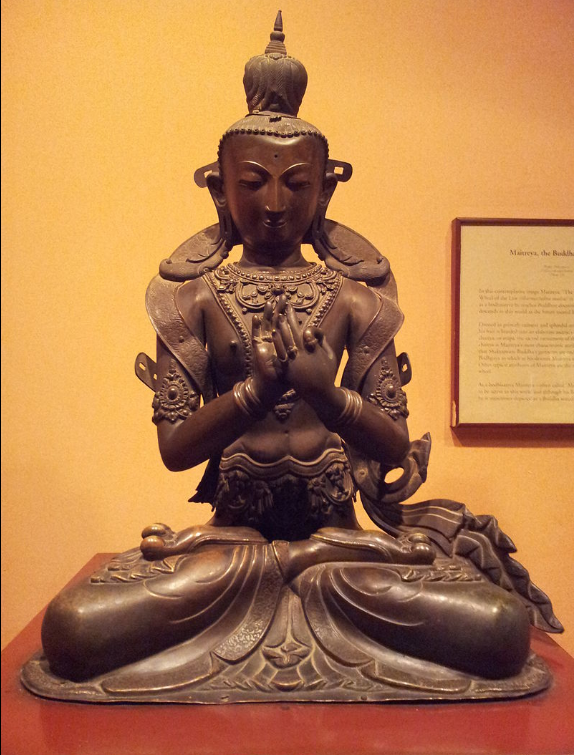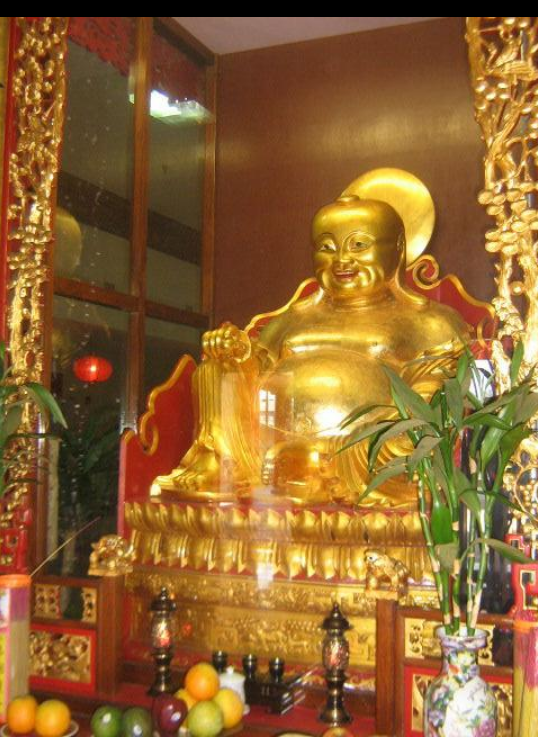Template:Infobox Buddha Maitreya (Sanskrit), Metteyya (Pali), is regarded as a future Buddha of this world in Buddhist eschatology. In some Buddhist literature, such as the Amitabha Sutra and the Lotus Sutra, he is referred to as Ajita. According to Buddhist tradition, Maitreya is a bodhisattva who will appear on Earth in the future, achieve complete enlightenment, and teach the pure dharma. According to scriptures, Maitreya will be a successor to the present Buddha, Gautama Buddha (also known as Śākyamuni Buddha). The prophecy of the arrival of Maitreya refers to a time in the future when the dharma will have been forgotten by most on the terrestrial world. Maitreya has also been adopted for his millenarian role by many non-Buddhist religions in the past, such as the White Lotus, as well as by modern new religious movements, such as Yiguandao.
- maitreya
- metteyya
- templateinfobox
1. Sources
The name Maitreya is derived from the Sanskrit word maitrī "friendship", which is in turn derived from the noun mitra "friend". The Pali form Metteyya is mentioned in the Cakkavatti-Sīhanāda Sutta (Digha Nikaya 26) of the Pāli Canon, and also in chapter 28 of the Buddhavamsa.[1][2] Most of the Buddha's sermons are presented as having been presented in answer to a question, or in some other appropriate context, but this sutta has a beginning and ending in which the Buddha is talking to monks about something totally different. This leads scholar Richard Gombrich to conclude that either the whole sutta is apocryphal or that it has at least been tampered with.[3]
In the Greco-Buddhist art of Gandhara, in the first centuries CE in northern India, Maitreya was the most popular figure to be represented along with Gautama Buddha (often called Śākyamuni "sage of the Shakya"). In 4th to 6th-century China, "Buddhist artisans used the names Shakyamuni and Maitreya interchangeably... indicating both that the distinction between the two had not yet been drawn and that their respective iconographies had not yet been firmly set".[4] An example is the stone sculpture found in the Qingzhou cache dedicated to Maitreya in 529 CE as recorded in the inscription (currently in the Qingzhou Museum, Shandong). The religious belief of Maitreya apparently developed around the same time as that of Amitābha, as early as the 3rd century CE.[5]
2. Characteristics
One mention of the prophecy of Maitreya is in the Maitreyavyākaraṇa. It implies that he is a teacher of meditative trance sādhanā and states that gods, men and other beings:
Will lose their doubts, and the torrents of their cravings will be cut off: free from all misery they will manage to cross the ocean of becoming; and, as a result of Maitreya's teachings, they will lead a holy life. No longer will they regard anything as their own, they will have no possession, no gold or silver, no home, no relatives! But they will lead the holy life of oneness under Maitreya's guidance. They will have torn the net of the passions, they will manage to enter into trances, and theirs will be an abundance of joy and happiness, for they will lead a holy life under Maitreya's guidance.[6]
3. General Description
Maitreya is typically pictured seated, with either both feet on the ground or crossed at the ankles, on a throne, waiting for his time. He is dressed in the clothes of either a bhikṣu (monk) or Indian royalty. As a bodhisattva, he would usually be standing and dressed in jewels. Usually he wears a small stupa in his headdress that represents the stupa with relics of Gautama Buddha to help him identify it when his turn comes to lay claim to his succession, and can be holding a dharmachakra resting on a lotus. A khata scarf is always tied around his waist as a girdle.
In the Greco-Buddhist art of Gandhara, Maitreya is represented as a northern Indian nobleman, holding a kumbha in his left hand. Sometimes this is a "wisdom urn" (Tibetan: Bumpa). He is flanked by his two acolytes, the brothers Asanga and Vasubandhu, who founded the Yogacara tradition.
The Maitreyasamiti was an extensive Buddhist play in pre-Islamic Central Asia.[7][8] The Maitreyavyakarana (in Sataka form) in Central Asia and the Anagatavamsa of South India also mention him.[9][10]
4. Maitreya's Tuṣita Heaven
Maitreya currently resides in the Tuṣita Heaven (Pāli: Tusita), said to be reachable through meditation. Gautama Buddha also lived here before he was born into the world as all bodhisattvas live in the Tuṣita Heaven before they descend to the human realm to become Buddhas. Although all bodhisattvas are destined to become Buddhas, the concept of a bodhisattva differs greatly in Theravada and Mahayana Buddhism. In Theravada Buddhism, a bodhisattva is one who is striving for full enlightenment (Arahantship in Pali), whereas in Mahayana Buddhism, a bodhisattva is one who has already reached a very advanced state of grace or enlightenment but holds back from entering nirvana so that he may help others.
In Mahayana Buddhism, Buddhas preside over pure lands, such as Amitābha over Sukhavati. Once Maitreya becomes a buddha, he will rule over the Ketumati pure land, an earthly paradise sometimes associated with the city of Varanasi (also known as Benares) in Uttar Pradesh, India, [11] and in other descriptions, the Shambhala.[12][13]
In Theravada Buddhism, Buddhas are born as unenlightened humans, and are not rulers of any paradise or pure land. Maitreya's arising would be no different from the arising of Gautama Buddha, as he achieved full enlightenment as a human being and died, entering parinibbana (nirvana-after-death).
5. Activity of Maitreya in the Current Age
In Mahayana schools, Maitreya is traditionally said to have revealed the Five Treatises of Maitreya through Asanga. These texts are the basis of the Yogacara tradition and constitute the majority of the third turning within the Three Turnings of the Wheel of Dharma.
6. Future Coming of Maitreya
According to Buddhist tradition, each kalpa has 1,000 Buddhas.[14] The previous kalpa was the vyuhakalpa (Glorious aeon), and the present kalpa is called the bhadrakalpa (Auspicious aeon).[15] The Seven Buddhas of Antiquity (Saptatathāgata) are seven Buddhas which bridge the vyuhakalpa and the bhadrakalpa:[16]
- Vipassī (the 998th Buddha of the vyuhakalpa)
- Sikhī (the 999th Buddha of the vyuhakalpa)
- Vessabhū (the 1000th and final Buddha of the vyuhakalpa)
- Kakusandha (the first Buddha of the bhadrakalpa)
- Koṇāgamana (the second Buddha of the bhadrakalpa)
- Kassapa (the third Buddha of the bhadrakalpa)
- Gautama (the fourth and present Buddha of the bhadrakalpa)
Maitreya will be the fifth and future Buddha of the bhadrakalpa, and his arrival will occur after the teachings of Gautama Buddha are no longer practiced.
The coming of Maitreya will be characterized by a number of physical events. The oceans are predicted to decrease in size, allowing Maitreya to traverse them freely. Maitreya will then reintroduce true dharma to the world.
His arrival will signify the end of the middle time, the time between the fourth Buddha, Gautama Buddha, and the fifth Buddha, Maitreya, which is viewed as a low point of human existence. According to the Cakkavatti Sutta: The Wheel-turning Emperor, Digha Nikaya 26 of the Sutta Pitaka of the Pāli Canon, Maitreya Buddha will be born in a time when humans will live to an age of eighty thousand years, in the city of Ketumatī (present Varanasi), whose king will be the Cakkavattī Sankha. Sankha will live in the palace where once dwelt King Mahāpanadā, but later he will give the palace away and will himself become a follower of Maitreya Buddha.[17]
The scriptures say that Maitreya will attain bodhi in seven days (which is the minimum period), by virtue of his many lives of preparation for buddhahood similar to those reported in the Jataka tales.
At this time a notable teaching he will start giving is that of the ten non-virtuous deeds (killing, stealing, sexual misconduct, lying, divisive speech, abusive speech, idle speech, covetousness, harmful intent and wrong views) and the ten virtuous deeds (the abandonment of: killing, stealing, sexual misconduct, lying, divisive speech, abusive speech, idle speech, covetousness, harmful intent and wrong views).
The Arya Maitreya Mandala, an order founded by Anagarika Govinda, is based on the idea of the future coming of Maitreya.
Buddhist texts from several traditions say that beings in Maitreya's time will be much bigger than during the time of Sakyamuni. In one prophecy his disciples are contemptuous of Mahakasyapa, whose head is no larger than an insect to them. Buddha's robe barely covers two fingers making them wonder how tiny Buddha was. Mahākāśyapa is said to be small enough in comparison to cremate in the palm of Maitreya's hand.[18]
6.1. Foretold Biography
Maitreya will be born to the Brahmins, Tubrahmā (father) and Brahmavadi (mother) in Ketumatī, which will be ruled by King Saṅkha, a Chakravarti. Maitreya's spouse will be Princess Sandamukkhī. His son will be Brahmavaṁsa. After the birth of his son, Maitreya will leave to practice asceticism. He will practice for 7 days. After the practice, he will be awakened under a Mesua ferrea tree. The disciples of Maitreya Buddha are:
- Asoka, an Agraśrāvaka and the right-hand chief disciple
- Brahmadeva, an Agraśrāvaka and the left-hand chief disciple
- Sumana, the right-hand Agasāvikā
- Padumā, the left-hand Agasāvikā
- Sīha, a primary attendant.
Maitreya will be 88 cubits (132 feet, 40 meters) tall and will live for 88,000 years. Like Maṅgala Buddha, his rays will make people hard to distinguish between day and night. His teachings will preserve for the next 180,000 years.[19] In the commentary of Anāgatavamsa, his teaching will last for 360,000 years.
7. Nichiren Buddhism and Maitreya as Metaphor

According to the Lotus Sutra in Nichiren Buddhism, all people possess the potential to reveal an innate Buddha nature during their own lifetimes, a concept which may appear to contradict the idea of Buddha as savior or messiah.
Although Maitreya is a significant figure in the Lotus Sutra, the explanation of Nichiren is that Maitreya is a metaphor of stewardship and aid for the Bodhisattvas of the Earth, as written in the Lotus Sutra:
Moreover... all the bodhisattvas, Bodhisattva Maitreya... will guard and protect the votaries of the Lotus Sutra, so one may indeed rest assured.[20]
In much of his writing, Nichiren mentions the traditional Buddhist views on Maitreya but explains that the propagation of the Eternal Dharma of the Lotus Sutra was entrusted by Shakyamuni to the Bodhisattvas of earth:
The Buddha did not entrust these five characters to Maitreya, Medicine King, or the others of their group. Instead he summoned forth the bodhisattvas... from the great earth of Tranquil Light and transferred the five characters to them.[21]
Thus, each individual can embody the character of the Maitreya because he is a metaphor for compassion:
The name Maitreya means ‘Compassionate One’ and designates the Votaries of the Lotus Sutra.[22]
8. Maitreya Claimants
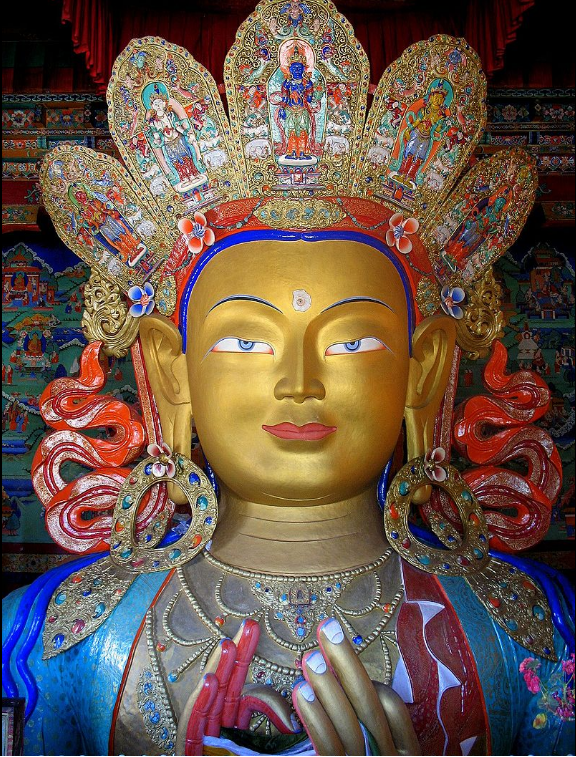
The following list is just a small selection of those people who claimed or claim to be the incarnation of Maitreya. Many have either used the Maitreya incarnation claim to form a new Buddhist sect or have used the name of Maitreya to form a new religious movement or cult.
- In 613 the monk Xiang Haiming claimed himself Maitreya and adopted an imperial title.[23]
- In 690 Wu Zetian, empress regnant of the Wu Zhou interregnum (690–705), proclaimed herself an incarnation of the future Buddha Maitreya, and made Luoyang the "holy capital." In 693 she temporarily replaced the compulsory Dao De Jing in the curriculum with her own Rules for Officials.[24]
- Gung Ye, a Korean warlord and king of the short-lived state of Taebong during the 10th century, claimed himself as the living incarnation of Maitreya and ordered his subjects to worship him. His claim was widely rejected by most Buddhist monks and later he was dethroned and killed by his own servants.
- Lu Zhongyi (1849-1925), the 17th patriarch of Yiguandao, claimed to be an incarnation of Maitreya.
- L. Ron Hubbard, founder of the belief systems Dianetics and Scientology, suggested he was "Metteya" (Maitreya) in the 1955 poem Hymn of Asia. Numerous editors and followers of Hubbard claim that in the book's preface, specific physical characteristics said to be outlined—in unnamed Sanskrit sources—as properties of the coming Maitreya were properties with which Hubbard's appearance supposedly aligned.
- Samael Aun Weor (1917-77) – stated in The Aquarian Message that "the Maitreya Buddha Samael is the Kalki Avatar of the New Age." The Kalkian Avatar and Maitreya Buddha, he claimed, are the same "White Rider" of the Book of Revelation.
- Ram Bahadur Bomjon openly identifies himself with the "Next Buddha" Maitreya, calls himself Maitriya Guru and his followers claim "He plans to unite the world through a single Maitri religion, Maitri language and Maitri culture."
- Adi Da was suggested by his devotees to be Maitreya:
An All-Surpassing God-Man yet to come – a final Avatar, the ultimate Messiah, a consummate Prophet or Enlightened Sage, a Spiritual Deliverer who will appear in the 'late-time', the 'dark' epoch when humanity is lost, apparently cut off from Wisdom, Truth and God. Buddhists call that Expected One 'Maitreya'.[25]
- Followers of B.R. Ambedkar in the Dalit Buddhist Movement regard him as a bodhisattva, the Maitreya, although he never claimed it himself.[26][27]
- Many scholars and analists claimed Hindu Avatar Kalki as Maitreya.[28][29][30][31][32]
- Some Muslim writers including of Ahmadiyya Muslim Community claimed Islamic prophet Muhammad as Maitreya.[33][34]
9. Maitreya Sects in China
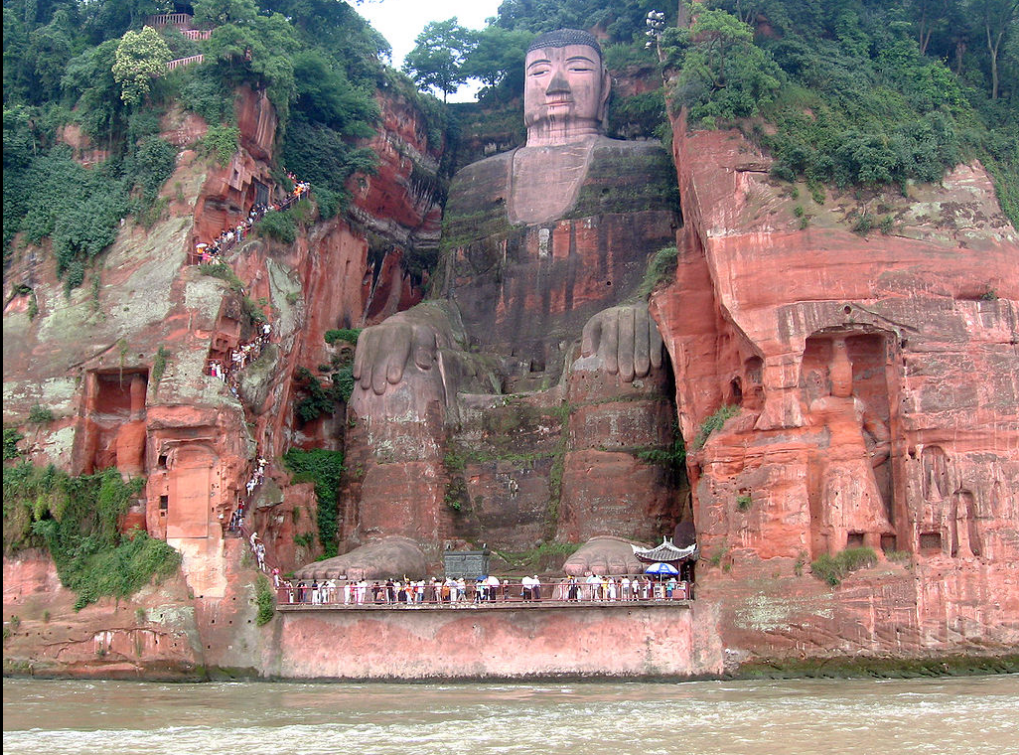
9.1. Pre-Maitreyan Buddhist Messianic Rebellions
Southern and Northern Dynasties
- 515: The 'Chinese Rebellion'. In the late summer of that year, the renegade monk Faqing 法慶 married a nun and formed a sect in the Northern Wei province of Jizhou 冀州 (in the southern part of today’s Hebei province) with the assistance of a local aristocrat named Li Guibo 李歸伯. Li Guibo was given the titles of Tenth-stage Bodhisattva, Commander of the Demon-vanquishing Army, and King who Pacifies the Land of Han by Faqing.
- Using drugs to send its members into a killing frenzy, and promoting them to Tenth-Stage Bodhisattva as soon as they killed ten enemies, the sect seized a prefecture and murdered all the government officials in it. Their slogan was "A new Buddha has entered the world; eradicate the demons of the former age", and they would kill all monks and nuns in the monasteries that they captured, also burning all the sutras and icons. After defeating a government army and growing to a size of over 50,000, the rebel army was finally crushed by another government army of 100,000. Faqing, his wife, and tens of thousands of his followers were beheaded, and Li Guibo was also captured later and publicly executed in the capital city Luoyang.
- The Fozu Tongji (Comprehensive Records of the Buddha), a chronicle of Buddhist history written by the monk Zhipan in 1269, also contains an account of the Rebellion, but with significant deviations from the original account, such as dating the rebellion to 528 rather than 515.[35]
- 516: The Moonlight Child Rebellion. Toward the end of that year, another sect was discovered by local authorities in Yanling, Jizhou. A man named Fa Quan and his associates were claiming that an eight-year-old child Liu Jinghui was a Bodhisattva called the Moonlight Child (yueguang tongzi pusa; 月光童子菩萨), and that he could transform into a snake or a pheasant. They were arrested and sentenced to death on suspicion of seditious intent, but Jinghui had his sentence commuted to banishment on account of his youth and ignorance.[35]
- 517: Early in the spring of that year, surviving remnants of the rebels regrouped and mounted a sudden attack on the capital of Yingzhou province, which lay just northwest of their original base in Bohai prefecture. They were repelled only after a pitched battle with an army of slaves and attendants led by Yuwen Yan, the son of the provincial governor, and nothing more is known of their fate.[35]
Although a "new Buddha" was mentioned, these rebellions are not considered "Maitreyan" by modern scholars.[35] However, they would be a later influence on the rebel religious leaders that made such claims. Therefore, it is important to mention these rebellions in this context.
9.2. Maitreyan Rebellions
Sui Dynasty
- 610: On the first day of the Chinese New Year, dozens of rebels dressed in white, burning incense and holding flowers proclaimed their leader as Maitreya Buddha and charged into the imperial palace through one of its gates, killing all the guards before they were themselves killed by troops led by an imperial prince. A massive investigation in the capital (Chang'an) implicated over a thousand families.[35]
- 613: A skilled magician named Song Zixian claimed to be Maitreya in Tang County (northwest of Yingzhou), and allegedly could transform into the form of a Buddha and make his room emit a glow every night. He hung a mirror in a hall that could display an image of what a devotee would be reincarnated as: a snake, a beast or a human being. Nearly a thousand "from near and far" joined his sect every day, and he plotted to first hold a Buddhist vegetarian banquet, or wuzhe fohui, and then attack the emperor who was then touring Yingzhou. The plot was leaked, and Song was arrested and executed, along with over a thousand families of his followers.[35]
- 613: The monk Xiang Haiming claimed to be Maitreya in Fufeng prefecture (western Shaanxi) and led a rebellion. The elite of the Chang’an area hailed him as dasheng, or holy man, because they had auspicious dreams after following him, and his army swelled to several tens of thousands before he was defeated by government troops.[35]
Tang Dynasty
- 710: Wang Huaigu declared, "The Shakyamuni Buddha has declined; a new Buddha is about to appear. The House of Li is ending, and the House of Liu is about to rise".[23]
Song Dynasty
- 1047: Army officer Wang Ze led a revolt of Buddhists expecting Maitreya; they took over the city of Beizhou in Hebei before they were crushed.[36] The Song Dynasty government declared Maitreya Sects to be "heresies and unsanctioned religions". Tens of thousands of Maitreya Sect followers were killed.[37]
Yuan and Ming Dynasty
- 1351: The Red Turban Rebellion (aka The First White Lotus Rebellion). Han Shantong (韓山童), leader of the White Lotus Society, and Army Commander Liu Futong (Chinese: 劉福通) rebelled against the Mongols of the Yuan dynasty. Shantong's anti-Mongol slogan was "The empire is in utter chaos. Maitreya Buddha has incarnated, and the Manichaean King of Light has appeared in this world."[23]
- In 1355, Han Shantong's son, Han Lin'er (Chinese: 韓林兒, 1355–1368?), was proclaimed "Emperor of the Great [Latter] Song" (大宋, referring to the defunct Song dynasty) by Liu Futong. Liu Futong claimed Han Lin'er was a direct descendant of the Zhao royal family who ruled the Song Dynasty. After Liu Futong's death, Zhu Yuanzhang took up command of the Red Turban Rebellion and later assassinated Han Lin'er to become the Hongwu Emperor of the Ming dynasty. (See History) According to Beijing University,
The leader of White Lotus sect, Han Shantong called himself Ming Wang (明王 – "King of Brightness"), while his son, Han Lin'er called himself Xiao Ming Wang (小明王 – "Small King of Brightness"), both names reflecting the sect's beliefs. Zhu Yuanzhang had been a member of the White Lotus Sect, and admitted to have been a branch of the White Lotus rebel army (being at one time vice-marshal of Xiao Ming Wang). When Zhu Yuanzhang took power, he chose the dynastic name "Ming".[38]
This suggests that the Ming dynasty was named after the White Lotus figures of the "Big and Little Bright Kings".
Qing Dynasty
- 1796: The White Lotus Rebellion (aka The Second White Lotus Rebellion). It broke out among impoverished settlers in the mountainous region that separates Sichuan province from Hubei and Shaanxi provinces. It apparently began as a White Lotus Society protest against heavy taxes imposed by Manchu rulers of the Qing Dynasty.[39]
- The Yi He Tuan (義和團), often called in English the "Society of Harmonious Fists" was a 19th-century martial-sect inspired in part by the White Lotus Society. Members of the "Harmonious Fists" became known as "Boxers" in the west because they practiced Chinese martial arts.
- 1899: The Boxer Rebellion (義和團之亂). Chinese rebellion from November 1899 to September 7, 1901 against foreign influence in such areas as trade, politics, religion and technology that occurred in China during the final years of the Qing Dynasty. By August 1900, over 230 foreigners, tens of thousands of Chinese Christians, an unknown number of rebels, their sympathizers and other innocent bystanders had been killed in the chaos. The uprising crumbled on August 14, 1900 when 20,000 foreign troops entered the Chinese capital, Peking (Beijing).
Albeit not in the name of Maitreya, both rebellions were perpetrated solely or in part by the White Lotus Society, a rebellious Maitreya sect.
10. Speculation
Some have speculated that inspiration for Maitreya may have come from Mithra, the ancient Indo-Iranian deity. The primary comparison between the two characters appears to be the similarity of their names, while a secondary comparison is that both were expected to come in the future.[40]
Paul Williams claims that some Zoroastrian ideas like Saoshyant influenced the beliefs about Maitreya, such as "expectations of a heavenly helper, the need to opt for positive righteousness, the future millennium, and universal salvation". Possible objections are that these characteristics are not unique to Zoroastrianism, nor are they necessarily characteristic of the belief in Maitreya.
It is also possible that Maitreya Buddha originated with the Hindu Kalki, and that its similarities with the Iranian Mithra have to do with their common Indo-Iranian origin.
11. Non-Buddhist Views
11.1. Theosophy
In theosophy, the theosophical Maitreya has multiple aspects signifying not just the future Buddha, but similar concepts from other religious or spiritual traditions.[41]
In early 20th century, leading theosophists became convinced that an appearance of the Maitreya as a so-called "World Teacher" was imminent. A South Indian boy, Jiddu Krishnamurti, was thought to be destined as the "vehicle" of the soon-to-manifest Maitreya; however the manifestation did not happen as predicted, and did not fulfil theosophists' expectations.[42]
11.2. Post-Theosophical Movements
Since the growth of the theosophical movement in the 19th century, and influenced by theosophy's articulations on the Maitreya, non-Buddhist religious and spiritual movements have adopted and reinterpreted the concept in their doctrines. Share International, which equates Maitreya with the prophesied figures of multiple religious traditions, claims that he is already present in the world, but is preparing to make an open declaration of his presence in the near future. They claim that he is here to inspire mankind to create a new era based on sharing and justice.[43]
In the beginning of the 1930s, the Ascended Master Teachings placed Maitreya in the "Office of World Teacher" until 1956, when he was described as moving on to the "Office of Planetary Buddha" and "Cosmic Christ" in their concept of a Spiritual Hierarchy.
In 1911, Rudolf Steiner claimed "Roughly three thousand years after our time the world will experience the Maitreya Buddha incarnation, which will be the last incarnation of Jeshu ben Pandira. This Bodhisattva, who will come as Maitreya Buddha, will also come in a physical body in our century in his reincarnation in the flesh — but not as Buddha — and he will make it his task to give humanity all the true concepts about the Christ Event." Steiner is careful to distinguish Jeshu ben Pandira as somebody entirely distinct from Jesus of Nazareth, as the Maitreya is entirely distinct from the Christ being. The Maitreya does work in support of the Christ being, as does Gautama, the current Buddha. [44]
11.3. Ahmadiyya
The Ahmadiyyas believe Mirza Ghulam Ahmad (1835-1908) fulfilled expectations regarding the Maitreya Buddha.[45]
11.4. Bahá'í Faith
Bahá'ís believe that Bahá'u'lláh is the fulfillment of the prophecy of appearance of Maitreya.[46][47] Bahá'ís believe that the prophecy that Maitreya will usher in a new society of tolerance and love has been fulfilled by Bahá'u'lláh's teachings on world peace.[46]
11.5. Korean Shamanism
In many East Asian folk religions, including Korean shamanism, a deity by the name of Maitreya appears as an ancient creator god or goddess. A malevolent usurper deity by the name of Shakyamuni (the historical Buddha) claims dominion over Maitreya's world, and the two engage in a flower-growing contest to decide who will rule the world. Maitreya grows the flower while Shakyamuni cannot, but the usurper steals it while the creator sleeps. Shakyamuni thus becomes the ruler of the world and brings suffering and evil to the world.[48]
12. Gallery
-

Maitreya (water bottle on left thigh), art of Mathura, second century CE
-

A 9th-century Srivijayan art bronze Maitreya from South Sumatra, a stupa adorns his crown
-
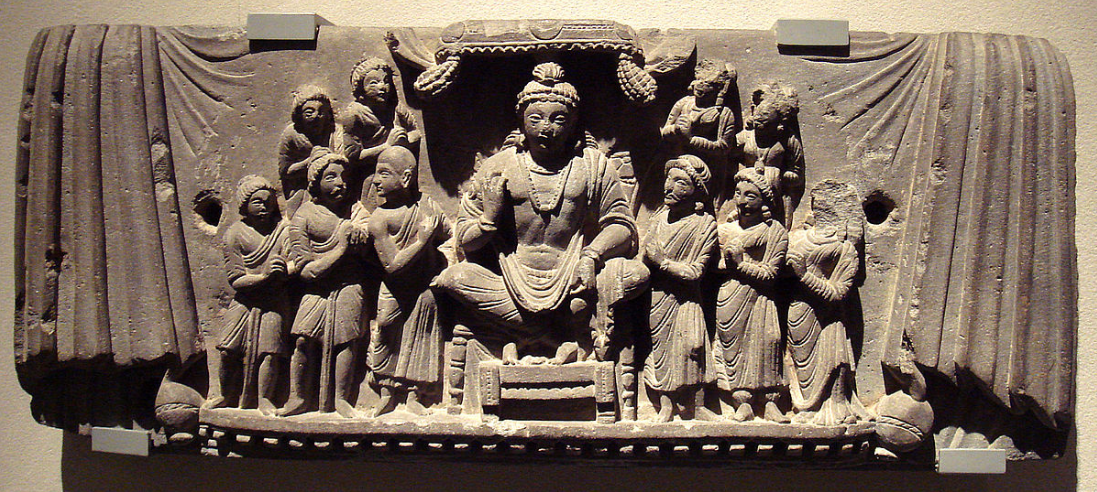
The future Buddha Maitreya, Gandhara, 3rd century CE. By PHGCOM - self-made, photographed at Ostasiatische Kunst Museum, CC BY-SA 4.0, https://commons.wikimedia.org/w/index.php?curid=3473311
-
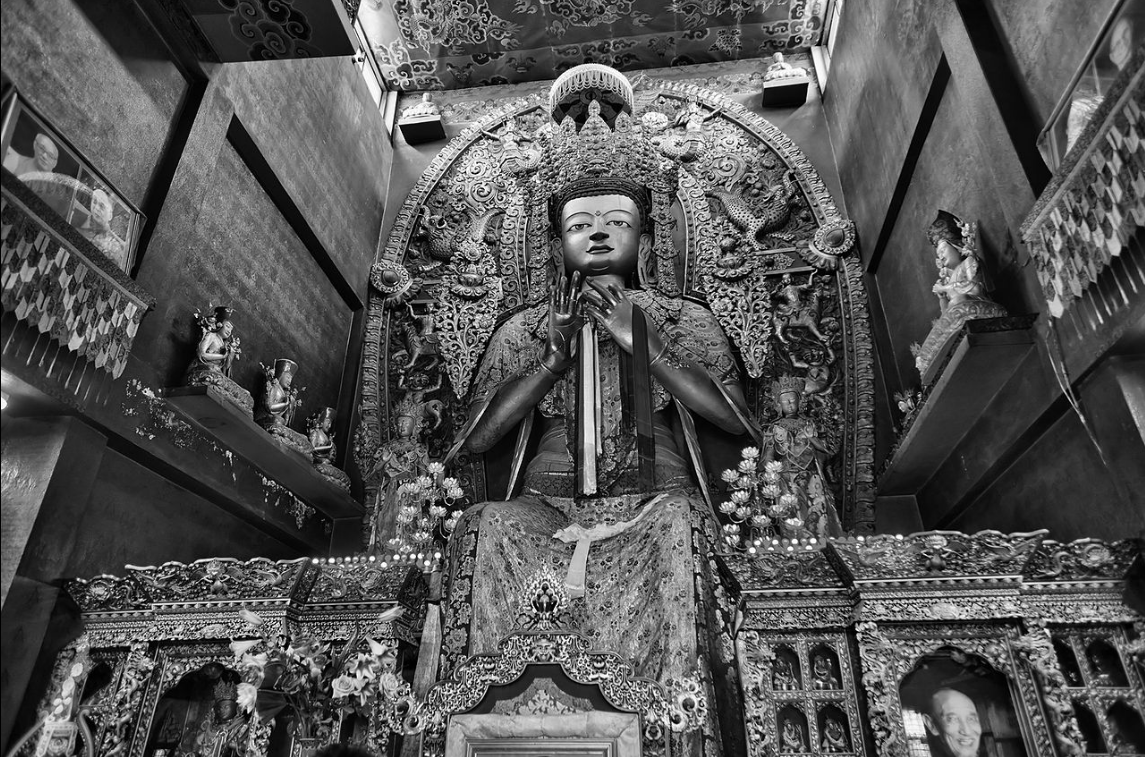
A statue of Maitreya Buddha inside Trikal Maitreya Buddha Vihara (Jamchen Lhakhang Monastery) at Bouddhanath premises, Kathmandu, Nepal. By Alexander Shafir - Own work, CC BY-SA 3.0, https://commons.wikimedia.org/w/index.php?curid=35550240
-

Seated Maitreya, Korean, 4-5th century CE. Guimet Museum. By I, PHGCOM, CC BY-SA 3.0, https://commons.wikimedia.org/w/index.php?curid=2443679
-
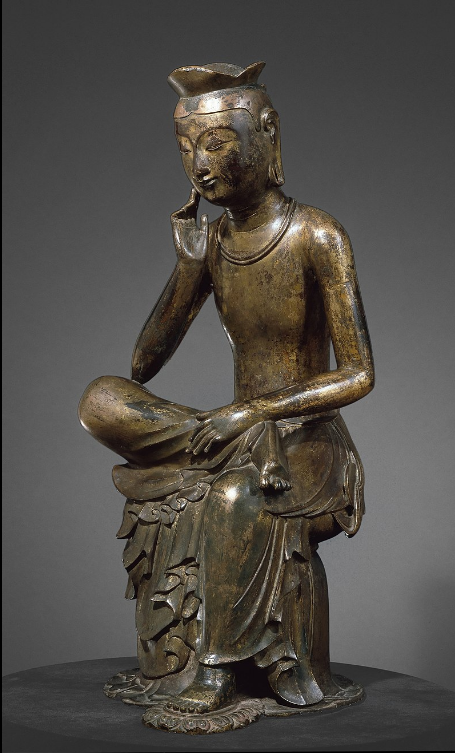
Seated Maitreya in meditation, Korean, 6-7th century CE. By Ismoon (talk) 18:41, 30 January 2018 (UTC) (File:Pensive Bodhisattva 02.jpg , cleared and a neutral grey, more contrast with Photoshop) - Own work, CC BY-SA 4.0, https://commons.wikimedia.org/w/index.php?curid=65983100
-
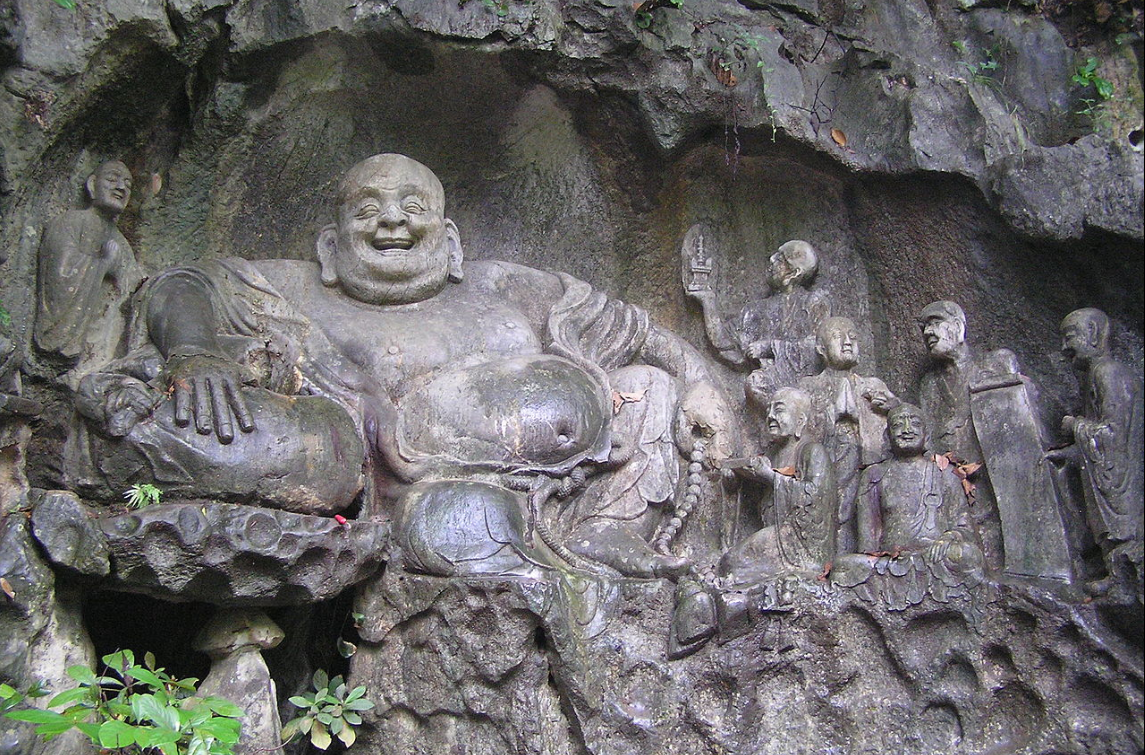
Maitreya and disciples in budai form, as depicted at the Feilai Feng grottos near Lingyin Temple in Hangzhou, China. By Mr. Tickle - Own work, CC BY-SA 3.0, https://commons.wikimedia.org/w/index.php?curid=289230
The content is sourced from: https://handwiki.org/wiki/Philosophy:Maitreya
References
- Horner (1975), The minor anthologies of the Pali canon, p. 97. Regarding Metteyya, Bv XXVII, 19: "I [Gautama Buddha] at the present time am the Self-Awakened One, and there will be Metteyya...."
- Buddha Dharma Education Association (2014). "Suttanta Pitaka: Khuddaka Nikāya: 14.Buddhavamsa-History of the Buddhas". Guide to Tipiṭaka. Tullera, NSW, Australia: Buddha Dharma Education Association. http://www.buddhanet.net/budvamsa.htm. Retrieved 2014-12-21.
- Richard Gombrich, Theravada Buddhism: A Social History from Ancient Benares to Modern Colombo. Routledge and Kegan Paul, 1988, pages 83–85.
- Angela Falco Howard et al., Chinese Sculpture, Yale University Press, 2006, p. 228
- (in zh) (PDF) 中國早期的彌勒信仰, TW: TT034, archived from the original on 2013-12-30, https://web.archive.org/web/20131230234200/http://www.tt034.org.tw/Download/pdf/20_03.pdf
- (Trans. in Conze 1959:241
- 古代维吾尔语说唱文学《弥勒会见记》 http://www.eurasianhistory.com/data/upload/mile.doc
- The Maitreya-samiti and Khotanese http://www.gengo.l.u-tokyo.ac.jp/~hkum/pdf/Maitreya_Paris.pdf
- 刘震:从百颂体《弥勒授记经》来看中印及周边的文化交流 http://www.iahs.fudan.edu.cn/pdf/%B4%D3%B0%D9%CB%CC%CC%E5%A1%B6%C3%D6%C0%D5%CA%DA%BC%C7%BE%AD%A1%B7%C0%B4%BF%B4%D6%D0%D3%A1%BC%B0%D6%DC%B1%DF%B5%C4%CE%C4%BB%AF%BD%BB%C1%F7.pdf
- The Teaching of the Elders – Thera-vada: 'Anagatavamsa Desana http://maungpaw.blogspot.com/2006/12/anagatavamsa-desana.html
- 《彌勒上生經》與《彌勒下生經》簡介 http://enlight.lib.ntu.edu.tw/FULLTEXT/JR-BJ013/51013.pdf
- (in en) Arch. orient. Nakl. Ceskoslovenské akademie věd.. 2003. pp. 254, 261. https://books.google.com.bd/books?id=pb4TAQAAMAAJ&q=maitreya+shambhala&dq=maitreya+shambhala&hl=en&sa=X&ved=0ahUKEwjwmZvDkaDpAhUCcCsKHW0fAJIQ6AEIVTAH. Retrieved 11 May 2020.
- Roerich, Nicholas (2003) (in en). Shambhala. Vedams eBooks (P) Ltd. p. 65. ISBN 978-81-7936-012-5. https://books.google.com.bd/books?id=xRDUA5ZpNJsC&pg=PA65&dq=maitreya+shambhala&hl=en&sa=X&ved=2ahUKEwjMrfjWkaDpAhXadn0KHSKDAQg4ChDoATADegQIARAY#v=onepage&q=maitreya%20shambhala&f=false. Retrieved 11 May 2020.
- "Chapter 36: The Buddhas in the three periods of time". Buddhism in a Nutshell Archives. Hong Kong: Buddhistdoor International. http://www.buddhistdoor.com/OldWeb/bdoor/archive/nutshell/teach36.htm. Retrieved 2014-12-21.
- Buswell Jr., RE; Lopez Jr., DS (2014). The Princeton Dictionary of Buddhism (1st ed.). Princeton, New Jersey: Princeton University Press. pp. 106. ISBN 978-0-691-15786-3. https://books.google.com/?id=DXN2AAAAQBAJ&pg=PA106&lpg=PA106&dq=Buddhas+of+the+present+kalpa#v=onepage&q=Buddhas%20of%20the%20present%20kalpa&f=false.
- Buswell Jr., RE; Lopez Jr., DS (2014). The Princeton Dictionary of Buddhism (1st ed.). Princeton, New Jersey: Princeton University Press. pp. 776. ISBN 978-0-691-15786-3. https://books.google.com/?id=DXN2AAAAQBAJ&pg=PA106&lpg=PA106&dq=Buddhas+of+the+present+kalpa#v=onepage&q=Seven%20Buddhas%20of%20Antiquity&f=false.
- Vipassana.info, Pali Proper Names Dictionary: Metteyya http://www.vipassana.info/me_mu/metteyya.htm
- John S. Strong (2007). Relics of the Buddha. p. 220. ISBN 0691117640. https://books.google.com/books/about/Relics_of_the_Buddha.html?id=_KLAxmR8PZAC.
- Myanmar Encyclopedia, Volume 9
- "SGI Library Online – The Writings of Nichiren Daishonin". Sgilibrary.org. http://www.sgilibrary.org/view.php?page=1074&m=3&q=all%20the%20bodhisattvas,%20Bodhisattva%20Maitreya. Retrieved 2012-08-15.
- "SGI Library Online – The Writings of Nichiren Daishonin". Sgilibrary.org. http://www.sgilibrary.org/view.php?page=437&m=3&q=The%20Buddha%20did%20not%20entrust%20these%20five%20characters. Retrieved 2012-08-15.
- The Record of Orally Transmitted Teachings p 143.Translated by Burton Watson
- Notable Maitreyan Rebellions, FYSM068—Collective Violence and Traumatic Memory in Asia. 16 October 2005. Retrieved 29 November 2006. https://web.archive.org/web/20060911211331/http://academic.hws.edu/chinese/huang/fysm068/outline13.ppt#10
- Tang Dynasty Empire 618–906, SAN-BECK. Retrieved 29 November 2006. http://www.san.beck.org/AB3-China.html#4
- Carolyn Lee. Adi Da: The Promised God-Man Is Here by The Ruchira Sannyasin Order of Adidam Ruchiradam. Amazon.com. ISBN 1570971439.
- Fitzgerald, Timothy (2003). The Ideology of Religious Studies. Oxford University Press. p. 129. ISBN 978-0-19-534715-9. https://books.google.com/books?id=R7A1f6Evy84C&pg=PA129.
- Bose, M.B. (2017). Tereza Kuldova and Mathew A. Varghese. ed. Urban Utopias: Excess and Expulsion in Neoliberal South Asia. Springer. pp. 144–146. ISBN 978-3-319-47623-0. https://books.google.com/books?id=6c9NDgAAQBAJ&pg=PA144.
- Powell, Robert; Isaacson, Estelle (2013). Gautama Buddha's Successor. SteinerBooks. ISBN 978-1-58420-162-5. https://books.google.com.bd/books?id=vGhAAwAAQBAJ&pg=PT32&dq=Maitreya+Kalki&hl=en&sa=X&ved=0ahUKEwj-t7yMmrvpAhUFbn0KHQViCVYQ6AEIJDAA#v=onepage&q=Maitreya%20Kalki&f=false. Retrieved 17 May 2020.
- Roerich, Elena Ivanovna (1987). Letters, 1929-1938. Agni Yoga Society. https://books.google.com.bd/books?id=-6zwAAAAIAAJ&q=Maitreya+Kalki&dq=Maitreya+Kalki&hl=en&sa=X&ved=0ahUKEwj-t7yMmrvpAhUFbn0KHQViCVYQ6AEIVjAH. Retrieved 17 May 2020.
- Plott, John C.; Dolin, James Michael; Hatton, Russell E. (1977). Global History of Philosophy: The period of scholasticism. Motilal Banarsidass Publishe. p. 358. ISBN 978-0-89581-678-8. https://books.google.com.bd/books?id=ErMRGiNcxJIC&pg=PA358&dq=Maitreya+Kalki&hl=en&sa=X&ved=2ahUKEwiIuu6Em7vpAhXbb30KHQmcDU84ChDoATAFegQIARAj#v=onepage&q=Maitreya%20Kalki&f=false. Retrieved 17 May 2020.
- Lawrence, Troy (1990). New Age Messiah identified: who is Lord Maitreya? : Tara Center's "mystery man" alive and living in London. Huntington House Publishers. p. 62. ISBN 978-0-910311-17-5. https://books.google.com.bd/books?id=RJo4wL49kugC&q=Maitreya+Kalki&dq=Maitreya+Kalki&hl=en&sa=X&ved=2ahUKEwiKpd3Am7vpAhXYcn0KHTpvCgY4FBDoATAIegQIARA8. Retrieved 17 May 2020.
- Stutley, Margaret (1985). Hinduism: The Eternal Law : an Introduction to the Literature, Cosmology and Cults of the Hindu Religion. Aquarian Press. ISBN 978-0-85030-348-3. https://books.google.com.bd/books?id=OPsXAAAAIAAJ&q=Maitreya+Kalki&dq=Maitreya+Kalki&hl=en&sa=X&ved=2ahUKEwiIuu6Em7vpAhXbb30KHQmcDU84ChDoATAIegQIARA8. Retrieved 17 May 2020.
- Faruqui, Mumtaz Ahmad (2015-04-16) (in en). Anecdotes from the Life of the Prophet Muhammad. Ahmadiyya Anjuman Ishaat Islam Lahore USA. ISBN 978-1-934271-27-8. https://books.google.com.bd/books?id=_53oJUrf1AgC&pg=PT63&dq=muhammad+maitreya&hl=en&sa=X&ved=0ahUKEwiJ_6antOjpAhVjwzgGHSy4CkoQ6AEIQDAE#v=onepage&q=muhammad%20maitreya&f=false.
- Middya, Fardun Ali (2018-12-10) (in en). Mentions of Prophet Muhammad: Peace be Upon Him and His Family. Educreation Publishing. pp. 29. https://books.google.com.bd/books?id=h3F7DwAAQBAJ&pg=PA29&dq=muhammad+maitreya&hl=en&sa=X&ved=0ahUKEwiJ_6antOjpAhVjwzgGHSy4CkoQ6AEIOTAD#v=onepage&q=muhammad%20maitreya&f=false.
- Yang Shao-yun (2004). Buddhist Political Ideology in the Rebellion and Moonlight Child Incident of 6th century China ((Honors thesis, National University of Singapore) (Thesis). Archived from the original on 5 October 2006. Retrieved 29 November 2006. https://web.archive.org/web/20061005171702/http://www.chinahistoryinfo.com/index.php?id=42,95,0,0,1,0
- Song Dynasty Renaissance 960–1279, SAN-BECK. Retrieved 29 November 2006. http://www.san.beck.org/AB3-China.html#5
- Is Qigong Political? A new look at Falun Gong QI: The Journal of Traditional Eastern Health & Fitness. Retrieved 29 November 2006. http://qi-journal.com/Qigong.asp?-Token.FindPage=4&-Token.SearchID=Is%20Qigong%20Political
- "白莲教的首领韩山童称"明王"(他的儿子韩林儿称"小明王"),都体现其教义宗旨。朱元璋不仅曾经信仰白莲教,而且承认自己是白莲教起义军的一支(他曾为小明王左副元帅)。朱元璋取得政权后,国号称"明"。Beijing University http://www.hist.pku.edu.cn/club/printpage.asp?BoardID=2&ID=1804
- White Lotus Rebellion, The Columbia Encyclopedia, Sixth Edition. May 2001. Retrieved 29 November 2006. http://www.bartleby.com/65/wh/WhiteLot.html
- Tiele, CP (1912). "Appendix: some Buddhistic parallels". The religion of the Iranian peoples. I. (from the German) with Darmesteter's sketch of "Persia" and Goldziher's "Influence of Parsism on Islam (1st ed.). Bombay: The Parsi Publishing Co. p. 159. https://archive.org/stream/religionofirania00tielrich#page/159/mode/1up. "No one who has studied the Zoroastrian doctrine of the Saoshyants or the coming saviour-prophets can fail to see their resemblance to the future Maitreya."
- Leadbeater, Charles W. (2007) [originally published 1925. Adyar, India: Theosophical Publishing House]. The Masters and the Path (reprint ed.). New York: Cosimo Classics. ISBN:978-1-60206-333-4. The theosophical Maitreya features prominently in the entire work. Some instances pertinent here: pp. 4–5, 10, 31–32, 34, 36, 74; "Part IV: The Hierarchy" pp. 211–301. As it did with practically every major religious, philosophical, and cultural tradition, theosophy ascribed additional occult or esoteric significance to many Buddhist concepts. In the theosophical Spiritual Hierarchy the Maitreya is currently high in the ranks of the so-called "Masters of the Ancient Wisdom" where he also holds the "Office of the World Teacher". According to theosophical writers he has had a number of manifestations or incarnations in the physical plane, and he has been further identified with Christ; Besant, Annie & Leadbeater, Charles W. (1913). Man: How, Whence, and Whither; a record of clairvoyant investigation. Adyar, India: Theosophical Publishing House. pp. 339, 520. OCLC 871602. Presumed prior Maitreya incarnations. https://www.worldcat.org/oclc/871602
- Lutyens, Mary (1975). Krishnamurti: The Years of Awakening. New York: Farrar Straus and Giroux. ISBN:0-374-18222-1. Biography (partial) of Jiddu Krishnamurti, the presumed "vehicle" of the Maitreya in the 20th century, describes the events in some detail.
- Share International. http://shareintl.org/
- [1].
- Review of Religions, 97, March 2002, p. 24 .
- Momen, Moojan (1995). Buddhism And The Baha'i Faith: An Introduction to the Baha'i Faith for Theravada Buddhists. Oxford: George Ronald. pp. 50–52. ISBN 0-85398-384-4.
- Buck, Christopher (2004). "The eschatology of Globalization: The multiple-messiahship of Bahā'u'llāh revisited". in Sharon, Moshe. Studies in Modern Religions, Religious Movements and the Bābī-Bahā'ī Faiths. Boston: Brill. pp. 143–178. ISBN 90-04-13904-4. http://bahai-library.com/buck_eschatology_globalization.
- Waida, Manabu (1991). "The Flower Contest between Two Divine Rivals. A Study in Central and East Asian Mythology". Anthropos 86: 87-109. ISSN 0257-9774. http://www.jstor.org/stable/40462392. Retrieved June 10, 2020.

